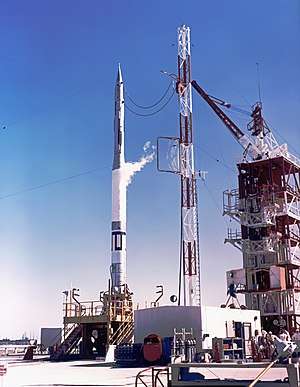Vanguard SLV-6
Vanguard SLV-6, also called Vanguard Satellite Launch Vehicle-Six, hoped to be the third successful flight of the American Vanguard rocket following the successful Vanguard 2 satellite on rocket Vanguard SLV-4. Vanguard SLV-6 launched on 22 June 1959 at 20:16 GMT. It was launched from Launch Complex 18A at the Cape Canaveral Air Force Station. The second stage helium control bottle valve failed to open properly at engine start. Tank and chamber pressures rapidly decayed during second stage burn, and 40 seconds after engine start, the helium bottle ruptured due to pressure buildup. The third stage then separated and ignited, driving itself and the satellite into the Atlantic Ocean 300 miles downrange.[1] [2] [3][4] [5]

The goal was to put two satellites into orbit: the Vanguard 3b satellite, a magnetometer to map the earth's magnetic field, and a 76 cm (30 in) inflatable sphere for optical tracking. Vanguard SLV-5 only reached an altitude of 140 km (87 mi); the goal was 3,840 km (2,390 mi) to orbit.[6]
Vanguard 3, carried on a Vanguard SLV-7 rocket, and launched on 18 September 1959, was the third successful Vanguard satellite and the last Vanguard rocket.
See also
References
Further reading
- Mallove, Eugene F. and Matloff, Gregory L. The Starflight Handbook: A Pioneer's Guide to Interstellar Travel, Wiley. ISBN 0-471-61912-4.